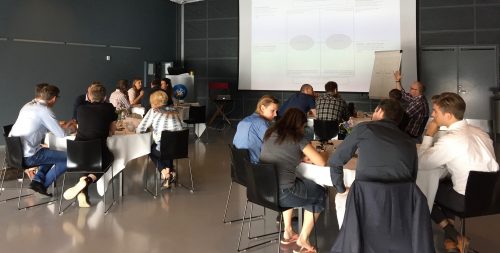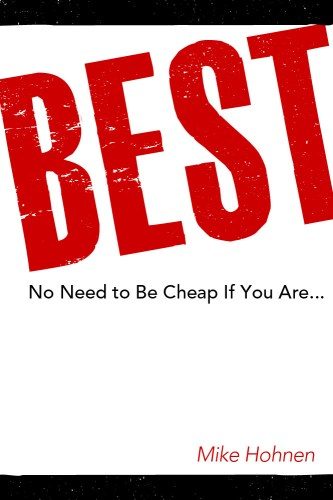
In the previous video blog, we looked at how what we believe shapes our approach to learning and development. So the obvious question is how can we change what we believe?
That is what this video is about:
Coaching for personal growth, change and development
By Mike Hohnen

In the previous video blog, we looked at how what we believe shapes our approach to learning and development. So the obvious question is how can we change what we believe?
That is what this video is about:
By Mike Hohnen

Last week, we looked at the knowing-doing gap and some of the causes behind that. But your mindset is possibly the biggest hindrance in closing your knowing-doing gap. That is what this week’s video is about.
Download The Mindset Checkup Test
Next week, we will have a look at what it takes to change our beliefs.
By Mike Hohnen

If you want to reap the full benefits of your investment in training courses, you need to make a plan for what you are going to do when the course is over, because that is when the magic really happens.
We know from the 70:20:10 model that most of our learning comes from what we do on the job. That is the 70%.
And we also know that if we always do what we always did, we will always get what we always got.
And even that is not quite accurate because research shows that if we just do what we do, without trying to get better, we will actually regress, and gradually get slightly worse. But that is another story.
So we need to inspire our team members to do something different than what they have always done. That is why we send them on a training course.
But if these training programs are just seen as an entertaining stand-alone event then they do not help us much, except maybe for a few high performers who have the drive to take the materials and build their own implementation program.
So assuming that only a few of our team players are so called high performers, we then need to manage how we can best support the ‘normal’ team members in actually trying out their new knowledge, experimenting, getting feedback and gradually improving in order to ultimately get really good at whatever it is they learnt on the training course. That was, after all, the objective of the whole exercise.
The key differentiator in this post-course learning phase is the team leader or the immediate supervisor.
Immediate supervisors, whether they are CEOs, VPs or floor managers come in basically two categories: Multipliers and Diminishers, writes Liz Wiseman, author of the book “Multipliers”.
Multipliers are essentially leaders who make everyone around them smarter, they consciously invest in the success of others. Their basic attitude is that people are smart and will figure it out and when they do, they become even smarter.
Multipliers ask lots of questions – Diminishers have all the answers.
Diminishers, on the other hand, create dependency. They often jump in and save the day. They drive results through their personal involvement and they are never shy to remind everyone how much smarter and more capable they are. When they do that, they drain the energy and motivation from everyone around them, and ultimately that reinforces the dependency.
Multipliers make sure that we get a high return on our training investment whereas diminishers time and again end up reducing all the time and effort that has been invested to nothing.
The key to being a great multiplier is to get people to think for themselves. They will never develop that ability if you always tell them what to do and how to do it. Learning means exercising some degree of choice, as opposed to working to a predetermined script. When you exercise your choice, you have an experience. That experience gives you feedback on how well you did. For most of us, this is a deeply motivating process. So building our capacity based on what we learnt on the course means trying things.
So the multiplier makes sure to hold a debrief meeting when a team member ‘returns’ from a formal training program. The purpose of the debrief is to establish what the team member is now going to work on in order to reinforce and build on the knowledge or inspiration that has been given in the course.
You’ll never change your life until you change something you do daily. The secret of your success is found in your daily routine.
– Johan C. Maxwell.
As with so many other new things, baby steps are the key. Don’t try and implement everything at once but make a plan. It’s the good old 20/80 principle again. What would be a small thing from the course that would make a big difference? That is a great starting point. Once we have that up and running, we move to the next item on the list, and step by step we build our capacity and performance. Use the GROW model to set it up.
So are diminishers evil egotist? No, most diminishers don’t even realise that they are draining the team. They actually mean well. They think they are being helpful. Next week, we will take a closer look at how not to fall into the trap of becoming a diminisher.
Check out Lis Wiseman’s book for yourself: Multipliers, Revised and Updated: How the Best Leaders Make Everyone Smarter
This the eleventh blog post in a series where Mike is exploring: Why is it important to develop not just yourself but also the people around you? You can read other posts in this series on Mike’s blog.
Building capacity is at the heart of the Service Profit Chain. If you are not familiar with the intricacies of is model, don’t forget to check out Mike’s online courses where you will find a lot of great tools, resources and knowledge on Leadership Development and The Service Profit Chain.
By Mike Hohnen

Quite a few years back now, the Center for Creative Leadership developed the 70:20:10 model for learning and development. The research behind the model shows that most of our learning (70%) stems from hands-on, on-the-job experiences. We mainly learn from what we do.
When we learn from others, it is typically in the form of coaching, mentoring and various forms of collaboration. This accounts for roughly 20% of our learning, and finally, the last 10% of our learning is based on courses, books, lectures etc., what we also call formal learning.
This then raises the question: Should we just forget about the formal part? Are courses and books just a waste of time?
If we look at the research on how high performers learn and develop, it becomes clear that there is a pattern.
High performers are typically quick to grasp the basics and when it comes to new learning, they often get this in the form of more formal structured courses, training or books. The 10% is their foundation. That is what they use to build their development on.
What makes them high performers is that the new knowledge inspires them and drives them to want to practice. They spend hours trying out their new learning. Through trial and error, self-testing and feedback, they gradually improve their capability.
They are also not shy to seek the support and help of colleagues. They may even take a coach for a period in order to make sure that they really get to master whatever the new skill is (Just look at any top performer in music, acting or sports and you will see exactly this pattern). They are not born like that, they work hard to get there.
It is their drive to improve that makes them high performers.
So back to the question about formal courses. Do we need them?
Yes, we do.
Because we need that basic input, that initial inspiration. But we must understand that if we do not reinforce the message and help set the scene for the additional 70% on the job learning and the 20% collaborative learning or coaching, then we have wasted our time and efforts.
That means that if you, as a manager, have had one of your team members on a course, you need to think about how you are going to support that person in developing and improving their skills, building on the foundational knowledge that they have acquired on the course.
Most of them are probably not what we would define as high performers, they are just great team members. And therefore, they do not have the drive or natural inclination to do this by themselves.
The knowing-doing gap
The first step in that process is to have a follow-up conversation with your team members when they return from the course. What have they learnt and most importantly, where do they see the knowing/doing gap? What is it that they now know, but that they are currently not doing?
How can you then, as this person’s manager, make sure that your team member gets to practice these new aspects? This takes us back to our famous GROW model.
If you have forgotten what that is about, check it out here.
You multiply the value of the course experience by at least 10 times if you help them actually implement what they are learning. But don’t forget, no feedback, no learning.
If you want to further maximise their learning, make sure that they team up with one or two others who also did the course and have them form an action learning triad or let them have the support of an experienced coach. That way you will also make sure you have covered the 20% that comes from collaboration and/or coaching.
In my experience, this is the way to create sustainable change. The key is not the learner as much as their immediate supervisor.
In this context, the immediate supervisor comes in one of two basic types: the ‘Multiplier’ and the ‘Diminisher’. Being one or the other makes all the difference, as I will explain in next week’s post.
This the tenth blog post in a series where Mike is exploring: Why is it important to develop not just yourself but also the people around you? You can read other posts in this series on Mike’s blog.
Building capacity is at the heart of the Service Profit Chain. If you are not familiar with the intricacies of is model, don’t forget to check out Mike’s online courses where you will find a lot of great tools, resources and knowledge on Leadership Development and The Service Profit Chain.
By Mike Hohnen

Have you found yourself binge-watching the Netflix series or impatiently waiting for next week’s Scandinavian Noir episode to come on screen?
If you have, it is probably because you were attracted by the unfolding drama.
So let me quickly show you how it is done.
All the great stories are built on the same principle. You need three elements. A victim, someone who get into trouble. And in order for that to happen, we need a persecutor, someone or something that does the bad stuff. And then of course, we need someone to save our poor victim, a hero.
That in all its simplicity is the mechanics of the drama triangle. And if you pay attention, you will see that many of your favourite books and films follow that structure.

Now if you would like to spice this up a bit and make it run forever and ever. You let the participants change roles. Suddenly the hero is the victim. The persecutor becomes the new hero and the former victim is now the persecutor. If you have ever had the opportunity to watch Elisabeth Taylor and Richard Burton in “Who’s afraid of Virginia Woolf”, then you will recognise that this is what unfolds for the two riveting hours the movie runs. It is a masterful demonstration of the drama triangle.
Great entertainment, emotions all over the place, but no learning and no solutions.
Unfortunately, many of us chose to play out these drama triangles in our own lives with the same result. Lots of emotion no solution.
We make victims of ourselves as we complain about traffic, the boss or the weather. We call our best friend each Friday evening and once again ask so how is the job going, well knowing that it will be the same sob-story as last week (The job is a disaster, the boss is an idiot etc.) but we satisfy our inner hero by encouraging our poor friend to tell that story again and again.
Or even worse, we give space to our inner persecutor by criticising a spouse or colleague only to turn around the next minute and be their hero by telling them not to take it so hard etc.
On and on it goes, you probably have your own version.
Just watch in your next management meeting, how this unfolds time and again, and how you already know who is going to play what role. Only here there is not much entertainment because we know the script and it is so, so boring.
We need to break the habit and stop playing this game with each other. The trick is to make a conscious decision to GROW out of it. There are no constructive solutions in a drama triangle. And the way to stop it is to ask yourself or your colleague the magic question: What would you like to do about it? Or what do we need to achieve?
This is where the GROW coaching process comes in handy. It is your magic wand that instantly dissolves the drama triangle:
Every time we find ourselves in one of the three drama triangle roles, we need to apply this simple but powerful process. It stops the drama, creates solutions and furthers our learning and development.
And all it takes is one simple question: What would I like to create?
 This the eighth blog post in a series where Mike is exploring: Why and how to develop not just yourself but also the people around you?
This the eighth blog post in a series where Mike is exploring: Why and how to develop not just yourself but also the people around you?
Building capacity is at the heart of the Service Profit Chain. If you are not familiar with the intricacies of the Service Profit Chain, we have a special treat for you:
For this month only, you can access The Essential Leadership Instrument course on Mike’s training library for FREE using this coupon A2A3HUVRWV. It is only available for the first 50 people so first come first serve! Sign up HERE!
By Mike Hohnen

When implementing the philosophy of the Service Profit Chain, we often look at three core parts:
And all three are driven by the continuous development of your team.
Employee engagement is closely linked to job content. What do I get to do at work (the other part of a job is job context which is all about the condition you get to do your work in)? A key component of job content is the perception that I am growing and developing myself.
Any book or article you read about creating a customer-centric approach inevitably will talk about value. If we are not providing value, we do not have a business, not for very long at least. But values in a service business is a result of employee competencies. This has to do with the notion that services are asymmetric in their nature. What the client buys is not what we sell. The client has a need and we translate that need into our product. If you are going to do that better than your competition, it requires competent people.
And finally, customer loyalty is developed through skillful interaction that produces an emotional connection with our customers. Delivering the basic product according to specifications just ensures satisfaction; getting to loyalty requires so much more.
So you can do what many organisations do, hope that they will improve as they go.
Or you can do what the top performing service companies do, you can develop a culture of continuous improvement and learning that drives everything that you do.
If you are wondering what works best, let me help you…
Think about any type of human endeavour where we can observe that high performance is vastly different from just ordinary performance. Playing the piano, ballet dancing or competitive swimming just to name a few. In virtually every arena in which we observe excellence, we also see a commitment to continuous improvement…
We also know from research on learning that if you are good at something and you just do what you are good at every day, your performance will gradually deteriorate and get worse. Don’t believe me? So if you have had a drivers licence for more than 5 years, do you think you could pass a driver’s test tomorrow? See what I mean?
Only if you continue to practice can you maintain or even improve your performance.
So how do we build continuous perfomance into our day to day work? What can we do to make sure that our people are always learning and developing? That is going to be the theme for my next series of blog posts.
 During the months of April, May, and June, we will be focusing human development. Why is it important to develop not just yourself but also the people around you? And what are ways to do it when we already have plenty on our plate as it is?
During the months of April, May, and June, we will be focusing human development. Why is it important to develop not just yourself but also the people around you? And what are ways to do it when we already have plenty on our plate as it is?
Building capacity is at the heart of the Service Profit Chain. If you would like the full concept served up in one go, you will find Mike’s book Best! No need to be cheap if… HERE.
For this month only, you can download the book for FREE using this coupon JLXW8P9QSE. It is only available for the first 50 people so first come first serve. Download the book now!
Get fresh perspectives and practical wisdom on building authentic professional relationships that make your life easier.
Join my newsletter list here (published once a month)